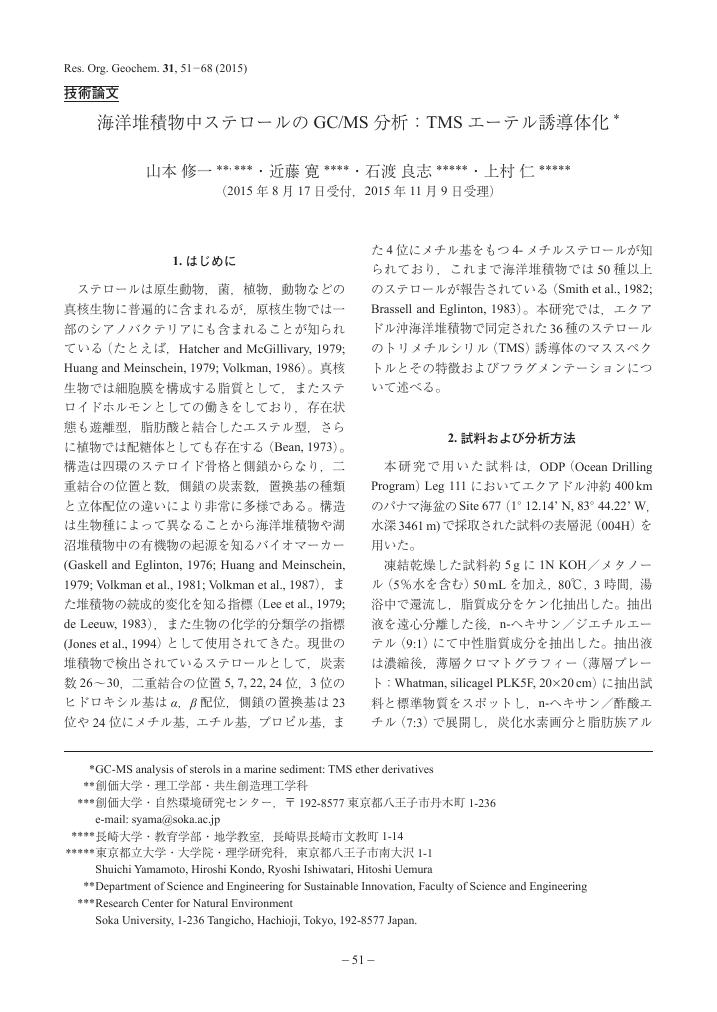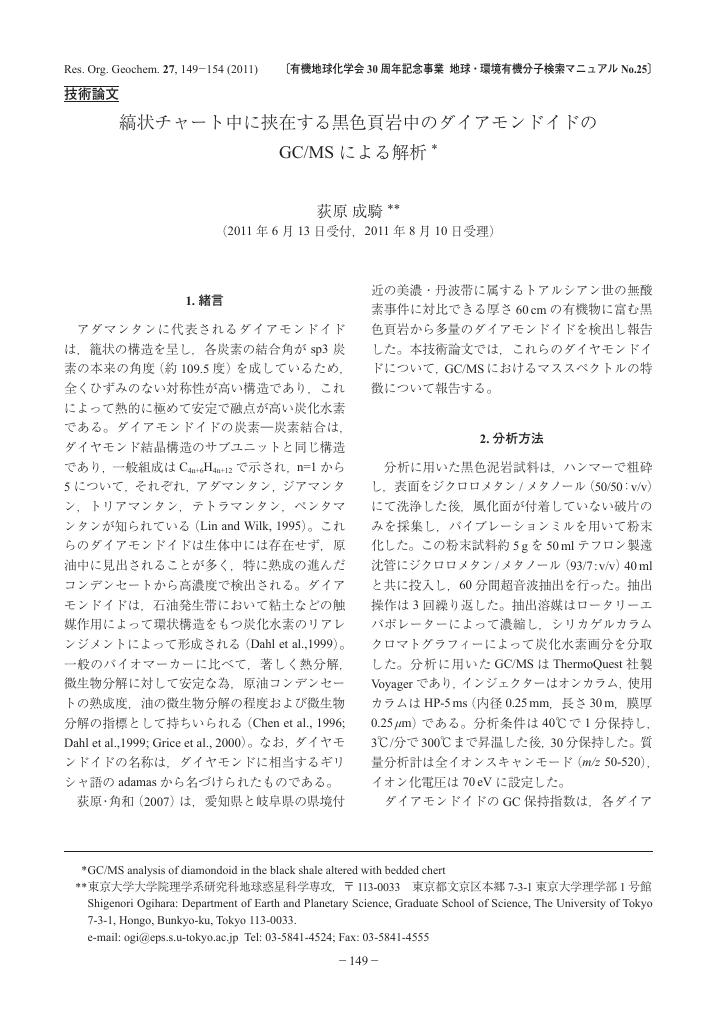- 著者
- 力石 嘉人 高野 淑識 小川 奈々子 佐々木 瑶子 土屋 正史 大河内 直彦
- 出版者
- 日本有機地球化学会
- 雑誌
- Researches in Organic Geochemistry (ISSN:13449915)
- 巻号頁・発行日
- vol.27, pp.3-11, 2011-09-30 (Released:2017-04-13)
- 参考文献数
- 30
- 被引用文献数
- 1
Recent evidences have suggested that compound-specific stable isotope analysis (CSIA) of amino acids has been employed as a new powerful method with that enables the estimation of trophic level of organisms in not only aquatic but also terrestrial food webs. This CSIA approach is based on contrasting the 15N-enrichment with each trophic level between two common amino acids: glutamic acid shows significant enrichment of +8.0‰ with each trophic level, whereas phenylalanine shows little enrichment of +0.4‰. These 15N-enrichments are well consistent in both aquatic and terrestrial organisms. The trophic level of organisms can be estimated within a small error as 1σ=0.12 for aquatic and 0.17 for terrestrial food webs, employing the eq.: [Trophic level]=(δ15Nglutamic acid-δ15Nphenylalanine+β)/7.6+1, where β represents the isotopic difference between these two amino acids in primary producers (-3.4‰ for aquatic cyanobacteria and algae, +8.4‰ for terrestrial C3 higher plants, and -0.4‰ for terrestrial C4 higher plants). Here, we briefly review this new method (i.e. CSIA of amino acids) and its application to natural organisms in terrestrial environments.
2 0 0 0 OA 湖底堆積物における不飽和脂肪酸
- 著者
- 河村 公隆 山崎 正夫 石渡 良志
- 出版者
- 日本有機地球化学会
- 雑誌
- Researches in organic geochemistry (ISSN:13449915)
- 巻号頁・発行日
- vol.2, pp.30-36, 1978-09
1.榛名湖,琵琶湖表層堆積物中にC_<18:2>,C_<18:3α>を含む不飽和脂肪酸を検出した。2.しかしその深度分布は二つの湖で大きく異なる。榛名湖では不飽和酸は飽和酸に対して深さとともに急速に減少するが,琵琶湖では大きな変化は観察されなかった。この差異の原因の一つとして堆積物の質的差異があげられる。3.琵琶湖の場合,5mまでの深さにおいてもC_<18:2>,C_<18:3>ポリ不飽和酸を検出した。それらは,0.2,2,3.5m附近で大きな濃度値を示した。これはポリオ飽和酸の供給量の変動によるものと解釈される。ポリ不飽和酸の供給量は当時の湖の水温,気温の変動を反映している可能性がある。
1 0 0 0 OA 長鎖脂肪酸の炭素同位体比を用いて過去の大気中二酸化炭素濃度を復元する試み
- 著者
- 山本 正伸
- 出版者
- 日本有機地球化学会
- 雑誌
- Researches in Organic Geochemistry (ISSN:13449915)
- 巻号頁・発行日
- vol.39, no.1, pp.1-12, 2023-07-14 (Released:2023-09-12)
- 参考文献数
- 40
Atmospheric carbon dioxide (CO2) is an essential factor in determining the Earth's climate. In predicting future warming, it is necessary to understand how atmospheric CO2 has affected past climate change. Past atmosphericCO2 concentrations have been determined by analyzing gases in ice cores drilled through the Antarctic ice. In this study, we show that the carbon isotope ratios of plant-derived fatty acids in the Bay of Bengal sediments represent past atmospheric CO2 concentration changes by comparing them with those in ice cores. Using this relationship, we have shown for the first time that atmospheric CO2 concentration changes before ca 800,000 years ago can be determined with high precision and high temporal resolution. The results show that even before ca 800,000 years ago, the CO2 concentration fluctuated almost synchronously with the volume of continental ice sheets. However, the CO2 concentrations were unexpectedly not high during the warm period prior to 1 million years ago. It was also found that the CO2 concentrations fluctuated earlier than the volumes of continental ice sheets before 1 million years ago but later than the ice volumes after ca 800,000 years ago.
1 0 0 0 OA 暁新世-始新世温暖化極大事件(PETM)研究の最前線 : 炭素同位体比層序学の貢献
- 著者
- 長谷川 卓
- 出版者
- 日本有機地球化学会
- 雑誌
- Researches in Organic Geochemistry (ISSN:13449915)
- 巻号頁・発行日
- vol.23.24, pp.43-52, 2008-12-30 (Released:2017-04-10)
- 参考文献数
- 41
The Paleocene-Eocene thermal maximum (PETM) is marked by a large negative carbon isotope excursion (CIE) and massive seafloor carbonate dissolution. Both phenomena are thought to have been caused by a sudden release of a large mass of carbon. The step-like nature of the CIE onset combined with the CIE magnitude has been explained by multiple dissociation of methane clathrate as the primary source of carbon. The natures of onset and the magnitude of CIE, however, are different between marine and terrestrial records implying potential artifacts in either or both records. Recently, the carbon isotope stratigraphy based on various techniques including compound-specific isotope analysis on terrestrial and marine biomarkers, single specimen analysis on surface-dwelling planktonic foraminifera revealed that 'actual' CIE is as large as 4‰ or larger, and the onset of the CIE was geologically instantaneous. These results demonstrated that the CIE magnitude (2-3‰) previously applied to estimate the mass of carbon released during the PETM was considerably underestimated and that abrupt input of 13C-depleted carbon to the ocean-atmosphere system. Forthcoming high-resolution studies on the PETM with precise inter-regional correlation would provide a unique opportunity for comparative research of global warming between PETM period and the present.
1 0 0 0 OA 海洋堆積物中ステロールのGC/MS 分析:TMS エーテル誘導体化
- 著者
- 山本 修一 近藤 寛 石渡 良志 上村 仁
- 出版者
- 日本有機地球化学会
- 雑誌
- Researches in Organic Geochemistry (ISSN:13449915)
- 巻号頁・発行日
- vol.31, no.2, pp.51-68, 2015-12-30 (Released:2016-11-07)
- 参考文献数
- 27
- 被引用文献数
- 1
1 0 0 0 中国,日本,マレーシアのエアロゾル中の多環式芳香族炭化水素組成
- 著者
- 熊田 英峰 高田 秀重 ザカリア モハマド パウジ
- 出版者
- 日本有機地球化学会
- 雑誌
- Researches in Organic Geochemistry (ISSN:13449915)
- 巻号頁・発行日
- vol.15, pp.13-25, 2000
- 参考文献数
- 35
- 被引用文献数
- 3
In order to investigate chemical fingerprints of different combustion sources, polycyclic aromatic hydrocarbons (PAHs) of airborne particulate samples were collected on three different occasions in Beijing (China), Tokyo (Japan) and Malaysia. Total-PAHs concentrations, including methyl- and dimethylphenanthrenes and sulfur containing hetero-aromatics (PASHs), were found to be the highest in Beijing (winter) samples followed by Beijing (summer), Tokyo, and Malaysia with readings of (405, 437), (20.4, 41.1), (8.43-43.1), and (2.64-42.6)ng/m<sup>3</sup>, respectively. Some of compositional differences observed could be due to the difference in combustion sources among the three countries rather than environmental alterations. Using ratios of benzo[ghi]perylene to benzo [e] pyrene (BghiP/BeP) and dimethylphenanthrenes to fluoranthene (DMP/Flu), Malaysian aerosols were elucidated from Tokyo and Beijing samples, suggesting high BghiP/BeP and DMP/Flu ratios as potential molecular markers of biomass-burning in the tropical region. Retene and 1,7-DMP/2,6-DMP ratio had previously been suggested as molecular markers for wood- or conifer-burning, were found to be useless in tropical region. Although PASHs were expected as molecular markers for the burning of sulfur-rich coal in China, ratios of PASHs to total-PAHs had showed only a slight enrichment in Beijing (winter) samples which was significantly affected by coal-combustion as compared to other samples in this study.
1 0 0 0 OA 縞状チャート中に挟在する黒色頁岩中のダイアモンドイドのGC/MSによる解析
- 著者
- 荻原 成騎
- 出版者
- 日本有機地球化学会
- 雑誌
- Researches in Organic Geochemistry (ISSN:13449915)
- 巻号頁・発行日
- vol.27, pp.149-154, 2011-09-30 (Released:2017-04-13)
- 参考文献数
- 6
- 著者
- 中村 英人 沢田 健
- 出版者
- 日本有機地球化学会
- 雑誌
- Researches in Organic Geochemistry (ISSN:13449915)
- 巻号頁・発行日
- vol.22, pp.31-42, 2007
- 参考文献数
- 16
The chemical compositions of woody fossil fragments collected by picking manually and density centrifugation from sandstones of the Lower Cretaceous Yezo Group in Oyubari, central Hokkaido, Japan were analyzed by KOH/methanol hydrolysis (saponification) after solvent extraction. Organic compounds bound in macromolecules of the woody fragments with ester bonds, obtained by saponification, were mainly composed of short-chain (C<sub>14</sub> to C<sub>18</sub>) fatty acids and series of <i>n</i>-alkanols ranging from C<sub>12</sub> to C<sub>28</sub> homologues. These ester bound constituents are attributed to moieties of polyester parts of selectively preserved resistant macromolecule like cutin or suberin. Even carbon-number predominance was observed in both compounds, which indicated that biological components were well preserved. The bound fatty acids showed similar distribution patterns among all samples, indicating that these moieties might have been altered by strong diagenetic processes. On the other hand, the distribution patterns of <i>n</i>-alkanols significantly varied. In particular, those of long-chain (>C<sub>20</sub>) <i>n</i>-alkanols varied possibly depending on plant taxonomy. Thus, we suggest that these parameters are strongly useful as molecular paleobiological indicators for chemotaxonomic analyses. Also, the distributions of short-chain <i>n</i>-alkanols and the ratios of short to long-chain homologues are presumably useful indicators for diagenesis, taphonomy and environment.
1 0 0 0 堆積有機分子から見たペルム紀末-前期三畳紀の地球環境変動
- 著者
- 齊藤 諒介
- 出版者
- 日本有機地球化学会
- 雑誌
- Researches in Organic Geochemistry (ISSN:13449915)
- 巻号頁・発行日
- vol.32, no.2, pp.19-53, 2016
<p>The mass extinction at the end of Permian was the severest crisis in the Earth's history. Oceanic euxinia and acidification as well as global warming all have been hypothesized as causes for the mass extinction. However, oceanic euxinia occurred much earlier than the mass extinction, and oceanic acidification and global warming postdated. Accordingly, the cause for the end-Permian mass extinction is not fully understood. Organic geochemical studies have been the most extensively performed for the mass extinction event, and revealed important findings such as soil erosion, photic zone euxinia, and proliferation of cyanobacteria for the event. Recovery from the mass extinction was much delayed and took place in the Middle Triassic, after 5 million years from the mass extinction. Subsequently, the Early Triassic period is the transition interval from the mass extinction to the recovery. The environments in the Early Triassic were rather instable, and another mass extinctions and recoveries repeatedly occurred. Organic geochemical studies have suggested photic zone euxinia, stressful environments, and an occurrence of a previously undiscovered type of microbialite during the Early Triassic. In the present paper, I introduce the evidences of environmental and biotic changes through the end-Permian mass extinction to the Early Triassic.</p>
- 著者
- 藤 加珠子 村江 達士 北島 富美雄
- 出版者
- 日本有機地球化学会
- 雑誌
- Researches in organic geochemistry (ISSN:13449915)
- 巻号頁・発行日
- vol.12, pp.21-26, 1997-05-30
Some type of macerals in sediments fluoresces under ultraviolet light. According to an increase of their maturity level, the wavelength of fluorescence maximum sifts toward longer wavelength, and intensity of the fluorescence diminishes. This property allows the fluorescence spectra to be a good maturity indicator for low immature sediment samples whose maturity can be hardly determined by vitrinite reflectance. However, correlations between thermal alteration of the fluorescent substances and the "red-shift" in the spectra are not clarified well. In this investigation, we examined thermal alteration of fluorescence spectra and chemical structures of fluorescent substances in the resinite from Latrobe Valley (Victoria, Australia). The samples were heated stepwise from 100℃ to 320℃ at 20℃ intervals for 15min at each temprature. We observed fluorescence spectra and ultraviolet-visible (UV-VIS) absorption spectra of the samples cooled after maintaining for 15min at each temperature. The "red-shift" in the fluorescence spectra was associated with alterations of UV-VIS absorptions. The IR spectra of the original samples and of the samples obtained after heating at the final temperature were also determined. No IR absorption bands due to aromatic rings appeared after the heating. These facts indicated that elongations of conjugated double bonds caused the "red-shift" of fluorescence.
- 著者
- 長谷川 卓
- 出版者
- 日本有機地球化学会
- 雑誌
- Researches in organic geochemistry (ISSN:13449915)
- 巻号頁・発行日
- vol.23, pp.43-52, 2008-12-30
The Paleocene-Eocene thermal maximum (PETM) is marked by a large negative carbon isotope excursion (CIE) and massive seafloor carbonate dissolution. Both phenomena are thought to have been caused by a sudden release of a large mass of carbon. The step-like nature of the CIE onset combined with the CIE magnitude has been explained by multiple dissociation of methane clathrate as the primary source of carbon. The natures of onset and the magnitude of CIE, however, are different between marine and terrestrial records implying potential artifacts in either or both records. Recently, the carbon isotope stratigraphy based on various techniques including compound-specific isotope analysis on terrestrial and marine biomarkers, single specimen analysis on surface-dwelling planktonic foraminifera revealed that 'actual' CIE is as large as 4‰ or larger, and the onset of the CIE was geologically instantaneous. These results demonstrated that the CIE magnitude (2-3‰) previously applied to estimate the mass of carbon released during the PETM was considerably underestimated and that abrupt input of ^<13>C-depleted carbon to the ocean-atmosphere system. Forthcoming high-resolution studies on the PETM with precise inter-regional correlation would provide a unique opportunity for comparative research of global warming between PETM period and the present.




